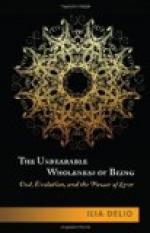was maintained; a unique event in the history of the
world was immortalised and systematised and all new
religious conceptions were excluded. Catholicism
invariably places all really important events in the
past, even in a quite definite period of the past,
a period unassailable by historical criticism.
But with the commencement of individual intellectual
life the uniform, ecclesiastical image of the Madonna
gradually gained life and individuality. Just
as according to Protestant teaching every soul must
establish its individual relationship with God (which
is subject to change because individuality is not
excluded as it is in Catholicism), so the imaginative
emotionalist created his own Queen of Heaven.
Frequently he was still under the impression—this
was especially the case with monks—that
he was worshipping the ecclesiastical deity, when he
had long been praying to a metaphysical conception
of his own. The great Italian art since the fourteenth
century, as well as the Neo-Latin and German cults
of the Virgin Mary were, though apparently still orthodox,
in their innermost essence the outcome of a personal
desire for love, and had therefore abandoned the teaching
of the Church and become Protestant. The fact
that the so-called Protestant Church looked askance
at Mary, and that the rather coarse-minded Luther said,
in his annoyance: “Popery has made a goddess
of Mary, and is therefore guilty of idolatry,”
does not contradict my statement. The true Queen
of Heaven was a conception of the artist and lover,
incomprehensible to those who were only thinkers and
moralists.
Through the legitimation of a divine woman open enmity
between the religion of woman and the religion of
the Church was avoided. A woman had stepped between
God and humanity as mediator, intercessor and redeemer.
Every metaphysically-loving soul could conceive her
as it pleased, could love her and pray to her without
being a heretic and worshipper of the devil.
Matfre had complained that men
Abandoned in her beauty
revel
And unawares adore the
devil.—
but now a means had been found to adore the beloved,
and yet remain faithful to God. Once in a way
it was remembered that the adored, strictly speaking,
was the Mother of God—if for no other reason,
for fear of the Inquisition which the Dominicans had
founded and placed under the special patronage of
Mary—her bodyguard as it were, defending
her from the onslaught of minds all too worldly.
Very rarely the adored earthly woman was identified
with the official Queen of Heaven—(this
may have been done occasionally by monks); sometimes
as in the case of Michelangelo and Guinicelli, the
beloved was the sole goddess; other poets, among whom
we may include Dante and Goethe, conceived her as
enthroned by the side of Mary.
At this point I must interrupt my argument, and briefly
sketch the position occupied by Mary in the western
world from the dawn of Christianity.




